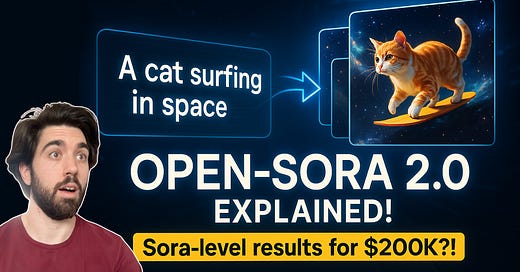How Open-Sora 2.0 Built Sora-Level Video AI for $200K
Open-Sora 2.0 Explained: Architecture, Training, and Why It Matters
Good morning, everyone! In this iteration, I'm sharing something I got from the Nvidia GTC event I attended last week.
GTC is Nvidia’s annual event, and I had the chance to check out some incredible new technology being shared in dozens of amazing talks.
One initiative that really caught my attention is a fully open-source video generator called Open‑Sora. They managed to train an end-to-end video generator, so taking text and generating a short video from it, with just 200,000$.
Okay, 200,000$ is a lot of money, but it’s quite low compared to what OpenAI’s Sora or other state-of-the-art video generation models cost, like Runway and the others I covered on my channel that require millions to train and get similar results.
How did they achieve that? What is "open-sora" and open-sora 2.0? How was it trained? That's what you'll learn in this iteration!
But before we dive in further, I’d love to introduce the sponsor of this iteration, with the goal of helping to work with open-source models like this one: Blueprints Hub by Mozilla.ai.
Developing with open-source AI shouldn’t be complicated. Instead of fighting each other and reinventing the wheel for every application, why not start with templates? That’s what Mozilla.ai aims to do.
Mozilla.ai’s Blueprint Hub gives you the tools to explore, collaborate, and start building with open-source local models quickly by using pre-configured templates designed for common applications.
There are tons of blueprints already available for easily fine-tuning models with federated learning to fine-tuning a speech recognition model for your voice that you can then quickly adapt to your project!
So whether you’re fine-tuning a speech model or building any type of AI-powered application, you’ll find trusted resources and a thriving community to support your journey.
Start building today with the Blueprints Hub!
Back to open-sora! Let’s begin by understanding the problem itself. Text-to-video generation isn’t like generating a single image from text; it’s about creating a sequence of images that flow together seamlessly over time. You have to capture not only all the fine spatial details of a scene, but also ensure that the motion is smooth and realistic over time.
This added temporal dimension introduces an entirely new layer of complexity and cost, mainly due to the fact that these AI systems don’t understand time. They only get tokens, which are either our words or pixels. They don’t have understandings of the laws of physics that human develop through trial and error when baby. They just have access to our world through tokens, making this video time-consistency extremely difficult.
There are essentially two approaches to tackle this problem.
The first is to train a model directly to convert text into video, which means the model has to learn both how to generate high‑quality images and how to stitch them together into coherent motion in one go, without any glitch or artifacts. Of course, this is ideal, and it’s what we want to end up with, but we have the same challenges I just mentioned.
But there’s a second approach, which instead takes a detour, simplifying the problem with a two‑step process: first, you train a model to generate a high‑quality image from a text prompt, and then you use that model and the image generated as a conditioning signal to generate a video.
Open‑Sora 2.0 adopts the second approach because it leverages mature techniques from image generation instead of training a whole end-to-end pipeline from scratch, as you will learn in this week's video (or written article here):
And that's it for this iteration! I'm incredibly grateful that the What's AI newsletter is now read by over 20,000 incredible human beings. Click here to share this iteration with a friend if you learned something new!
Looking for more cool AI stuff? 👇
Looking for AI news, code, learning resources, papers, memes, and more? Follow our weekly newsletter at Towards AI!
Looking to connect with other AI enthusiasts? Join the Discord community: Learn AI Together!
Want to share a product, event or course with my AI community? Reply directly to this email, or visit my Passionfroot profile to see my offers.
Thank you for reading, and I wish you a fantastic week! Be sure to have enough sleep and physical activities next week!
Louis-François Bouchard





